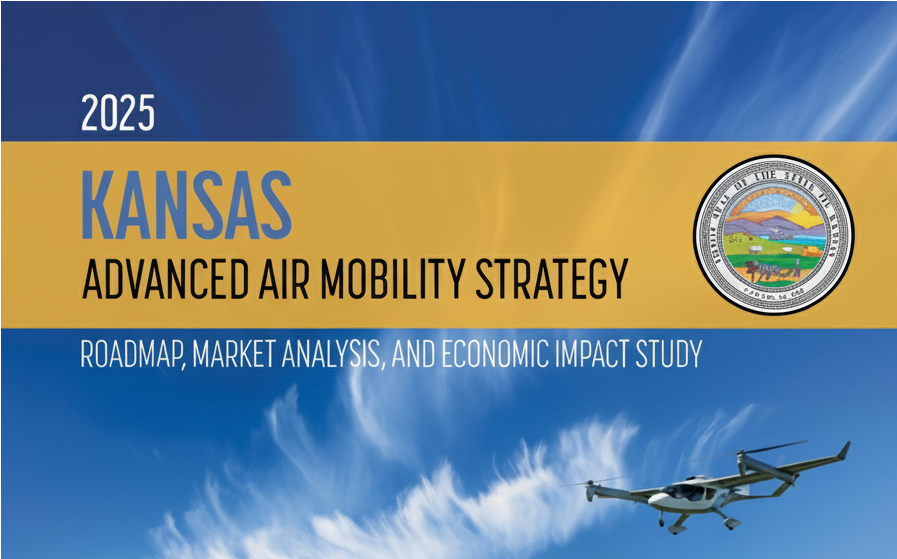Kansas has unveiled an ambitious roadmap to solidify its status as the Air Capital. The Kansas Advanced Air Mobility (AAM) Strategy, officially launched in September 2025, represents more than policy planning; it's a calculated positioning for economic leadership in an industry poised to transform transportation across rural and urban America.
The strategy emerges at a moment when electric vertical takeoff and landing aircraft, autonomous drones, and sophisticated air traffic management systems are transitioning from experimental concepts to commercial reality. Kansas, already home to 70% of the world’s general aviation fleet and an aerospace industry that contributes $7 billion to the state’s GDP, recognizes that maintaining its aviation leadership requires the proactive integration of these emerging technologies.
Building on Proven Aviation Assets
The foundation supporting Kansas’s AAM ambitions runs deep. With 146 public airports, three universities leading national aviation research, and over 450 aviation companies employing 34,000 skilled workers, the state possesses infrastructure and expertise that few regions can match. The annual $11 billion in economic activity generated by Kansas airports creates a substantial platform for expanding into advanced air mobility operations.
Kansas State University’s Salina Aerospace and Technology Campus, Wichita State University’s National Institute for Aviation Research (NIAR), and the University of Kansas collectively form a research triangle that has positioned Kansas as a center of excellence for unmanned aircraft systems through the Federal Aviation Administration’s ASSURE program. This academic foundation proves essential, as AAM development requires expertise spanning aerodynamics, battery technology, air traffic management, and the integration of autonomous systems.
The state’s strategic positioning received federal validation through the FAA’s BEYOND program, where Kansas serves as a lead participant among only eight selected nationwide. This designation provides direct access to regulatory development processes, positioning Kansas companies to influence how advanced air mobility operations will be certified and implemented across the United States.
Economic Implications Beyond Aviation
The economic ramifications of the AAM strategy extend well beyond traditional aviation boundaries. Rural healthcare delivery represents one of the most compelling immediate applications, as demonstrated by the successful August 2025 drone delivery of medical supplies between Seneca and Onaga, Kansas’s first long-range medical drone flight. Community HealthCare System’s CEO, John Fitzthum, highlighted how this technology could revolutionize rural medical supply chains, enabling the rapid delivery of blood products, antivenom, automated external defibrillators, and other critical supplies between hospitals and tertiary care centers.
Agriculture is Kansas's traditional economic cornerstone, standing to benefit substantially from expanded AAM operations. Kelly Hills Unmanned Systems operates a 49,000-square-mile FAA-approved test range spanning Kansas, Missouri, Nebraska, and Iowa, the largest commercial agricultural drone testing facility in the United States. This facility enables testing of precision agriculture applications, crop monitoring systems, and automated spraying technologies that can reduce input costs while improving environmental outcomes.
The workforce development implications prove equally significant. Kansas has already invested nearly $20 million through the Aviation Learning Opportunities & Funded Training (ALOFT) program to align worker skills with emerging aerospace technologies. Textron Aviation’s new Career & Learning Center in Wichita, which opened in 2024 as a primary training facility for 10,000 employees, exemplifies how major manufacturers are investing in workforce capabilities required for next-generation aircraft production.
Infrastructure Development and Rural Connectivity
The strategy addresses a fundamental challenge facing rural Kansas: access to and connectivity in transportation. Advanced air mobility offers solutions for communities where traditional transportation infrastructure proves inadequate or economically unfeasible. Electric vertical takeoff and landing aircraft can connect rural hospitals with urban medical centers, transport emergency personnel to remote locations, and provide cargo delivery services to underserved communities.
Vertiport infrastructure development presents both opportunities and challenges. While Kansas benefits from extensive existing airport infrastructure, AAM operations require specialized facilities with electric charging capabilities, autonomous aircraft maintenance systems, and integration with unmanned traffic management networks. The strategy recognizes that strategic vertiport placement could leverage existing multimodal transportation hubs while creating new economic development nodes in rural communities.
The state’s collaboration with industry leaders on infrastructure standards proves crucial. Companies like Siemens are working to establish universal eVTOL charging processes and “system of systems” approaches to support aircraft operations. Kansas’s involvement in these standardization efforts ensures the state’s infrastructure investments will align with emerging industry requirements.
Regulatory Leadership and Safety Integration
Kansas’s approach to AAM regulation demonstrates a sophisticated understanding of the balance between innovation and safety. The state participates in the FAA’s Electric Vertical Takeoff and Landing and Advanced Air Mobility Integration Pilot Program, providing real-world testing environments for the development of regulations. This involvement enables Kansas to shape how AAM operations are integrated into the National Airspace System, while ensuring that safety standards meet public expectations.
The strategy emphasizes beyond visual line of sight (BVLOS) operations as a critical capability for realizing the full potential of AAM. Current regulations limiting drone operations to visual line of sight severely constrain commercial applications. Kansas’s test facilities, particularly the Kelly Hills range, provide environments where extended-range operations can be evaluated under controlled conditions, generating safety data essential for expanded regulatory approval.
Counter-unmanned aircraft systems (cUAS) capabilities represent another regulatory consideration addressed in the strategy. As AAM operations expand, detecting, tracking, and potentially neutralizing unauthorized or malicious drone activities becomes essential for maintaining airspace security.
Multi-Stakeholder Coordination
The strategy’s implementation depends on coordination among government agencies, academic institutions, and private industry through the Emerging Aviation Technology Working Group. Monthly virtual meetings, with recordings posted on KDOT Aviation’s YouTube channel, ensure transparent communication and collaborative decision-making. This approach recognizes that successful AAM integration requires alignment across regulatory, technical, and commercial domains.
State agencies, including the Kansas Department of Transportation’s Division of Aviation and the Kansas Department of Commerce, collaborate with Kansas State University, Wichita State University, Kelly Hills Unmanned Systems, and local economic development organizations. This multi-stakeholder model ensures that policy development reflects both technical feasibility and commercial viability.
Competitive Positioning and Investment Attraction
The strategy’s "Come to Kansas to test and stay here to build” philosophy reflects the understanding that early-stage technology companies often establish long-term relationships with regions that support their development. Kansas offers unique advantages, including low operating costs, a skilled workforce, a favorable regulatory environment, and proximity to major aerospace manufacturers.
The state’s investment in aviation infrastructure continues to expand. Governor Laura Kelly’s signing of House Bill 2498 increased annual funding for the Kansas Airport Improvement Program from $5 million to $15 million, supporting the modernization of 109 public airports statewide. This infrastructure investment lays the foundation necessary for AAM operations while maintaining traditional aviation capabilities.
The Aviation and Innovative Manufacturing in Kansas (AIM-K) program provides additional investment incentives for aerospace manufacturers, sustainable aviation fuel producers, and advanced manufacturing companies. These incentives include capital investment tax credits, payroll tax rebates, and training reimbursements designed to attract companies developing next-generation aviation technologies.
Long-term Strategic Vision
Kansas’s AAM strategy extends beyond immediate commercial applications to position the state for long-term leadership in aviation technology development. The plan identifies seven key objectives: sustaining aviation leadership, aligning the ecosystem toward unified goals, identifying resource and investment needs, establishing industry attraction strategies, positioning Kansas for technology adoption, determining community connectivity opportunities, and identifying transportation system augmentation possibilities.
This comprehensive approach recognizes that AAM success requires more than technological capability, it demands integrated transportation planning, workforce development, infrastructure investment, and regulatory coordination. The strategy’s three-phase implementation timeline provides near-term, mid-term, and long-term milestones for measuring progress and adjusting approaches as the industry evolves.
The economic development potential appears substantial. National studies suggest AAM operations could generate tens of thousands of jobs and billions of dollars in economic activity over the coming decades. For Kansas, with its existing aviation assets and strategic positioning, capturing a significant portion of this growth could solidify the state’s role as America’s aviation capital for the next century.
The Kansas AAM strategy represents more than transportation policy, it's an economic development strategy disguised as aviation planning. By leveraging existing strengths in aerospace manufacturing, research capabilities, and regulatory relationships, Kansas positions itself to lead America’s transition to advanced air mobility. The success of this strategy will determine whether Kansas maintains its aviation leadership or watches other regions capture the economic benefits of aviation’s next evolution.
The ramifications extend beyond state borders. Kansas could become the model for how states integrate advanced air mobility into their transportation networks, economic development strategies, and regulatory frameworks. The strategy’s emphasis on rural connectivity, workforce development, and multi-stakeholder coordination provides a blueprint that other states may follow. For Kansas, the stakes couldn’t be higher, the future of its aviation leadership depends on how effectively it executes this ambitious vision.
Download PDF Whitepaper:




